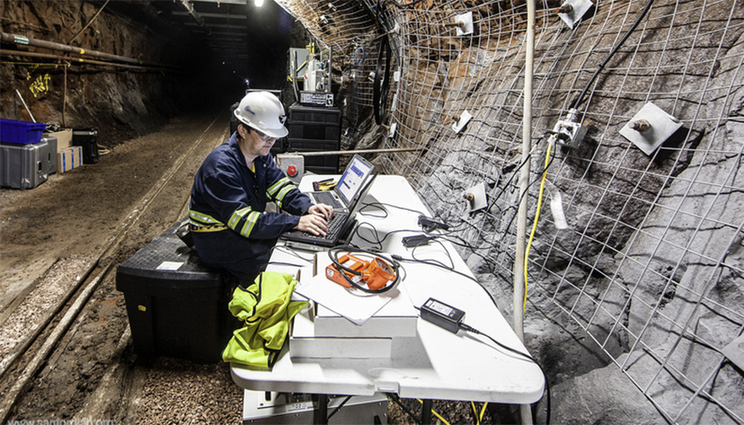Lab scientists dig in to geothermal systems
 (Download Image)
A scientist checks equipment as part of the kISMET (permeability (k) and Induced Seismicity Management for Energy Technologies) project in the Sanford Underground Research Facility. Photo by Matthew Kapust/Sanford Underground Research Facility
(Download Image)
A scientist checks equipment as part of the kISMET (permeability (k) and Induced Seismicity Management for Energy Technologies) project in the Sanford Underground Research Facility. Photo by Matthew Kapust/Sanford Underground Research Facility
Lawrence Livermore National Laboratory (LLNL) scientists play a significant role in a new project aimed at removing technical barriers to commercialize enhanced geothermal systems (EGS), a clean energy technology with the potential to power 100 million American homes.
In the $9 million Department of Energy (DOE) project, which is led by Lawrence Berkeley National Laboratory (LBNL), LLNL will partner with seven other DOE national labs and six universities to develop field experiments focused on understanding and modeling rock fractures, an essential element of geothermal systems. Scientists will use the Sanford Underground Research Facility (SURF) in South Dakota to create small-scale fracture networks in crystalline rock 1,500 meters below ground.
Conventional geothermal technology is possible only in locations with specific geological characteristics. These locations have the three components essential to extracting geothermal energy -- heat, fluid and permeability (a measure of how easily fluid can circulate through the rock’s fractures, picking up heat as it moves).
With EGS, a fracture network can be enhanced or engineered, thus bypassing the geographic limitations of conventional geothermal energy. EGS could eventually provide more than 100 gigawatts (GW) of economically viable, electric generating capacity in the continental United States, a huge increase over the current geothermal capacity of 3.5 GW.
LLNL scientists Joe Morris and Pengcheng Fu will apply state-of-the-art computational rock mechanics codes using high performance computing (HPC) to help design and evaluate results. LLNL’s Charles Carrigan, Xianijin Yang, Rob Mellors and Dennise Templeton will analyze geophysical data from novel fiber-based seismic sensors in combination with electrical imaging to monitor and understand fluid flow and micro-seismicity associated with the fracturing. Scientists Megan Smith and Susan Carroll will perform laboratory experimentation to predict and evaluate heat transfer in the fractures.
"We will be putting instrumentation within tens of meters of the fractures and will be able to detect fracturing at a higher resolution than what ever has been done before," said LBNL’s Tim Kneafsey, who leads the project. "The goal is to work toward commercialization of enhanced geothermal systems, which could eventually provide a very significant amount of electricity as there is a lot of accessible hot rock in this country."
This project will seek to understand the relationship between permeability creation and heat extraction in crystalline rocks under certain stress and temperature conditions.
The other national labs partnering in the project are: Sandia, Idaho, Los Alamos, Pacific Northwest, Oak Ridge and the National Renewable Energy Laboratory.
Knowledge gained from this project, dubbed EGS Collab, will feed into the flagship DOE geothermal project, the Frontier Observatory for Research in Geothermal Energy (FORGE). FORGE aims to develop the technologies needed to create large-scale, economically sustainable heat exchange systems, thus paving the way for a reproducible approach that will reduce risks that come with EGS commercialization.
This project is supported by DOE’s Office of Energy Efficiency and Renewable Energy (EERE), Geothermal Technologies Office.
Contact
 Anne M. Stark
Anne M. Stark
[email protected]
(925) 422-9799
Related Links
Sanford Underground Research FacilityFrontier Observatory for Research in Geothermal Energy
Lawrence Berkeley National Lab press release
Tags
Physical and Life SciencesFeatured Articles







